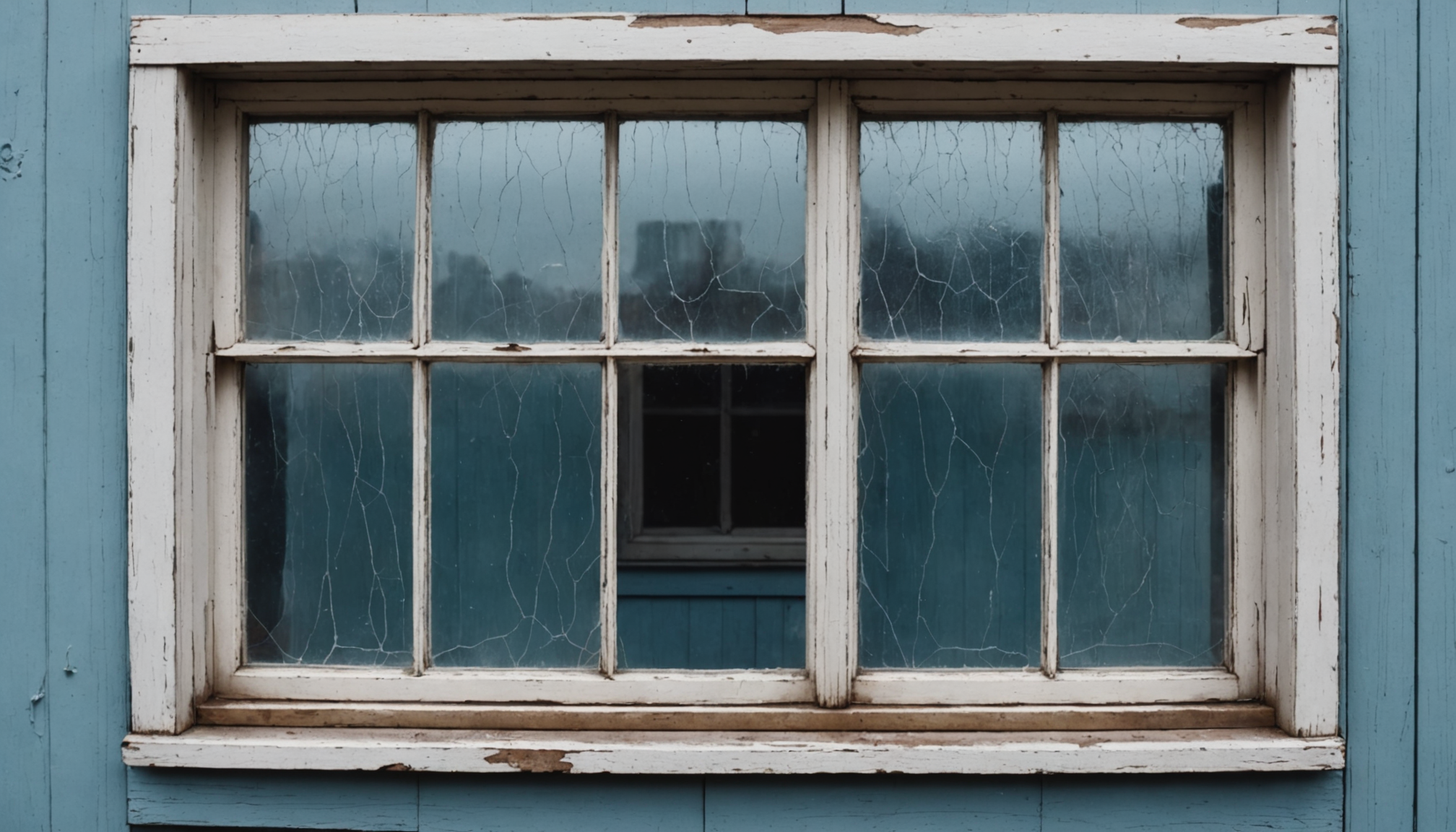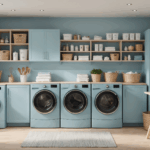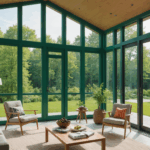Determining when it’s time to replace your windows can prevent a host of issues, from energy inefficiency to compromised home security. Windows serve as a crucial barrier between the interior of your home and the outside world, so recognizing the signs that indicate their need for replacement is essential for maintaining comfort and safety.
One of the primary indicators that your windows may need to be replaced is the presence of drafts. If you notice a significant temperature difference near your windows compared to the rest of your home, or if you feel a noticeable draft even when your windows are closed, it may indicate that the seals have failed or that the windows have warped over time. This not only affects comfort but can lead to increased heating and cooling costs as your HVAC system works harder to maintain a consistent indoor temperature.
Another common sign of windows nearing the end of their lifespan is condensation between the panes of glass. Modern windows are typically double or triple-paned, with inert gas between the panes to improve insulation. When the seals around these panes fail, moisture can seep in, leading to condensation. This not only obstructs the view but signals that the window’s insulating properties have been compromised. Left unaddressed, it can also lead to mold or mildew growth, which can affect indoor air quality.
Difficulty in opening, closing, or locking windows is also a significant indicator that replacement is necessary. Windows should open and close smoothly to ensure functionality and safety. If they stick, require excessive force, or won’t stay open or closed, it can detract from usability and pose potential security risks.
Noise is another factor to consider. Replacing windows can aid in soundproofing a home. If outside noise increasingly infiltrates your living space, even when windows are tightly shut, it might indicate that they are not providing adequate acoustic insulation. Modern windows are specifically designed to reduce noise pollution, making them a worthy investment if peace and quiet are priorities for your household.
The age of your windows can also play a key role in the decision to replace them. Most quality windows have a lifespan of 15 to 20 years. If your windows have surpassed this timeframe, or if you’re noticing a gradual decline in their performance, it may be more cost-effective in the long run to install new, energy-efficient models.
Beyond the practical aspects, aesthetic degradation is a more visible sign. Peeling paint, warped frames, or general structural deterioration not only detract from your home’s curb appeal but may also indicate underlying damage. This, combined with any visible water damage or rot around window frames, suggests that replacement should be considered sooner rather than later.
Here’s a table comparing old and new windows based on various attributes:
| Attribute | Older Windows | Newer Windows |
| Energy Efficiency | Lower, often single-pane | Higher, usually double or triple-pane with low-E coatings |
| Seal Integrity | Prone to seal failure | Improved sealing technology |
| Sound Insulation | Less effective | More effective |
| Aesthetic Appeal | Can degrade more easily | Available in modern designs and materials |
| Ease of Operation | Often cumbersome or stuck | Smoother mechanisms |
| Safety Features | Basic locks | Enhanced locking mechanisms |
Recognizing these signs early can help in planning for window replacement, ensuring that your home remains energy-efficient, secure, and visually appealing. This proactive approach not only contributes to maintaining the structural integrity of your home but also enhances its overall value.
benefits of new windows
Installing new windows in your home offers a variety of advantages that go beyond just aesthetics. While the immediate transformation in appearance is notable, the long-term benefits are what make the investment worthwhile. Here’s a detailed look at the key benefits of replacing old windows with new, modern options:
1. Enhanced Energy Efficiency
– Modern windows are designed with energy efficiency in mind, often featuring double or triple glazing and low-emissivity (low-E) coatings. These elements help to reduce heat transfer, maintaining a more consistent indoor temperature and lessening the need for excessive use of heating and cooling systems.
– Over time, the improved insulation can lead to significant savings on energy bills, making new windows a cost-effective choice for eco-conscious homeowners.
2. Improved Security
– New windows come equipped with advanced locking systems and tougher glass options, such as laminated or tempered glass, which provide a stronger barrier against break-ins.
– The additional security features not only protect your home and belongings but also offer peace of mind, knowing your home is safer.
3. Noise Reduction
– One of the often-overlooked advantages of new windows is their ability to reduce external noise. With better insulation and construction, modern windows minimize the intrusion of street sounds or noisy neighbors, creating a quieter and more serene indoor environment.
– This feature is particularly beneficial for homes located in busy urban areas or near main roads, where noise can be a consistent disturbance.
4. Enhanced Comfort
– By eliminating drafts and maintaining a more stable indoor climate, new windows contribute significantly to overall home comfort. You’ll find that rooms stay warmer in the winter and cooler in the summer, providing a more enjoyable living space.
– Insulated frames and multiple glazing layers also eliminate cold spots near windows, allowing you to use all areas of your home year-round.
5. Increased Home Value
– Window replacement stands out as one of the home improvements that offer a high return on investment (ROI). Potential buyers often see value in homes with new windows due to the associated energy savings and improved aesthetic appeal.
– An updated look can immediately increase your home’s curb appeal, contributing to a potential rise in property value.
6. Low Maintenance
– New windows are crafted from materials designed for longevity and low maintenance. For instance, vinyl and fiberglass frames do not require painting and resist warping and weather damage.
– Many newer window designs also feature easy-to-clean options, including tilt-in sashes, allowing for hassle-free upkeep without the need for specialized cleaning services.
7. Customization Options
– Homeowners can choose from a multitude of styles, colors, and finishes to match their home’s architectural aesthetic and personal taste.
– New windows offer a variety of operational types, such as casement, sliding, or awning, providing greater flexibility in design and functionality.
By focusing on these enhancements, new windows not only meet but often exceed the performance and aesthetic criteria that homeowners seek. Their practical benefits contribute to a higher quality of living and a more sustainable home environment, making them a wise investment for the future.
when to consider replacing mirrors
Mirrors, though often overlooked when considering household upgrades, can play a significant role in both design and functionality within your living spaces. Identifying the right time to replace mirrors is crucial for maintaining a nurturing and inviting home environment. Here are some factors to consider when deciding if it’s time to replace your mirrors.
Signs of Wear and Deterioration
Mirrors can show their age through visible wear and tear, such as discoloration along the edges, commonly referred to as “desilvering.” This occurs when the backing behind the glass begins to degrade, often seen as dark spots or cloudy areas that can obscure reflections. While some may view these imperfections as charming patina, excessive deterioration can detract from a room’s aesthetic and functionality. Additionally, scratches and cracks on the mirror surface are not just visually displeasing but can also pose a safety risk, making replacement an advisable option.
Change in Décor and Style
As home design trends evolve, your taste may too. Mirrors that once perfectly matched your style can feel outdated or clash with new décor themes. Replacing them with modern or more complementary designs can dramatically enhance the visual appeal and cohesion of a room. Mirrors offer tremendous versatility, allowing you to experiment with different shapes, sizes, and frames to create focal points, accentuate light, or add dimension to your spaces.
Enhancing Light and Space
One of the most powerful roles mirrors play in home decor is their ability to amplify light and create an illusion of space. If certain areas of your home are shadowy or cramped, strategically replacing smaller or poorly positioned mirrors with larger or more appropriately placed ones can make a significant impact. By reflecting light, mirrors can help illuminate dark corners and make rooms feel more open and airy. This is particularly beneficial in small apartments or areas with limited natural light.
Functionality Needs
Consider how you use your mirrors beyond aesthetics. In functional spaces like bathrooms, wardrobe rooms, and entryways, mirrors are essential tools. If your mirrors no longer meet your practical needs because they are too small, positioned inconveniently, or simply don’t provide the clarity needed for daily activities, it’s time to replace them. Opting for mirrors with enhanced features, such as built-in LED lighting or anti-fog coatings, can provide the utility you need in heavily used areas.
Safety Concerns
Any mirror with broken glass is an immediate candidate for replacement due to safety concerns. Broken edges not only pose a danger due to sharp shards, but they can also indicate structural weaknesses that could lead to further breakage. Moreover, if a mirror is not securely mounted or is in danger of falling, it should be replaced or remounted properly to prevent accidents.
In conclusion, replacing mirrors when they show signs of wear, clashing styles, or no longer serve your space as well as they could is a prudent decision. Not only do new mirrors provide functional improvements, but they also offer aesthetic benefits, instantly enhancing the ambiance and utility of your home. By considering these factors, you can make informed decisions that contribute to both the beauty and practicality of your living environment, ensuring mirrors remain a vital and vibrant part of your interior design strategy.
cost considerations and budgeting
Budgeting for window and mirror replacement projects is a key step in ensuring that the upgrade process is smooth, financially manageable, and meets your specific needs. When considering such investments, it’s important to take a comprehensive approach to cost analysis, factoring in both immediate expenses and long-term savings.
The first cost consideration is the type and quality of the materials you choose. Windows come in various materials such as vinyl, wood, aluminum, and fiberglass, each offering unique benefits and pricing structures. Vinyl windows, for instance, tend to be more affordable and provide good insulation, while wood windows are known for their aesthetic appeal but require more maintenance and can be more expensive. Similarly, mirrors vary in cost based on size, frame material, and additional features like anti-fog coatings or integrated lighting. Understanding the scale of your project and selecting materials that align with your budget and preferences is crucial.
Labor costs also play a significant role in your overall budget. Installation prices can vary widely based on your geographical location and the complexity of the installation. It’s advisable to obtain quotes from multiple contractors and verify their credentials and reviews. Hiring reputable professionals ensures a high-quality installation that prevents future issues and additional expenses. Be sure to ask about warranties on both the products and installation services, as these can save you money on future repairs.
In addition, consider the potential for long-term savings when budgeting for new windows. Although the initial investment might seem substantial, energy-efficient windows can reduce heating and cooling costs significantly over time, essentially helping the upgrade pay for itself. Similarly, new mirrors with energy-saving features, like those with built-in LED lighting, can contribute to reduced electricity usage.
When planning your budget, don’t overlook potential additional expenses such as permits, especially if your renovations are extensive or alter the overall structure or design of your property. Check with local authorities to ensure compliance with any relevant regulations.
Financing options are available if the upfront costs are a concern. Many companies offer financing programs, and some even provide discounts or rebates for choosing energy-efficient products. Researching these options thoroughly can alleviate the financial burden by spreading the cost over time.
Lastly, planning your project at the right time can also affect costs. Off-peak seasons, typically winter, may offer more competitive labor pricing and faster contractor availability. However, be mindful of the weather, as extreme conditions can delay or complicate installations.
By considering these factors in your budget, you can make informed decisions that balance cost-effectiveness with quality enhancements to your home. This strategic approach ensures that your window and mirror replacements not only fit within your financial plan but also add lasting value and comfort to your living space.
choosing the right time for replacements
Timing your window and mirror replacements strategically can maximize your benefits and minimize inconvenience. Key factors to consider include weather conditions, as they can impact both the ease of installation and the comfort of your home during the process. For windows, milder seasons like spring and fall often present ideal conditions, allowing contractors to work efficiently without temperature extremes that might affect materials or delay installation. Mirrors, while less dependent on weather, still benefit from scheduling during less busy times for contractors, allowing you to take advantage of better availability and potentially lower costs.
Your personal schedule is another crucial consideration. Plan your replacements when disruptions to daily life are manageable, avoiding times of high activity or when you host events that might stress your space’s aesthetics or functionality. Factor in the delivery and potential wait times for the selected materials. Popular window styles or custom mirrors may have longer lead times, so plan accordingly to prevent unnecessary delays.
Financial incentives and rebates can also influence the timing of your project. Many energy companies, as well as local governments, offer incentives for upgrading to energy-efficient windows, particularly at the start or end of fiscal quarters or years. Tapping into these benefits can significantly reduce costs. Keep an eye on seasonal sales or promotions, as manufacturers and retailers often lower prices during specific times of the year.
Lastly, if aiming to enhance your home’s value, consider the timing of replacements before a home appraisal or listing it on the market. Fresh, modern windows and mirrors can create a compelling first impression and increase property valuation.
By carefully choosing the timing for your window and mirror replacements, you can ensure a smooth process with optimal results. Planning with these factors in mind can lead to a more efficient, cost-effective, and satisfactory renovation experience. In conclusion, recognizing and acting on the signs that your windows and mirrors need replacement is vital to maintaining a well-functioning and attractive home. New windows offer unparalleled comfort, energy efficiency, and security, enhancing your living environment dramatically. Likewise, replacing mirrors when necessary can rejuvenate your spaces aesthetically and functionally. Taking into account cost considerations, and strategic timing for these upgrades, you can achieve a balance between affordability and high quality, ultimately leading to a more enjoyable and valuable home.


